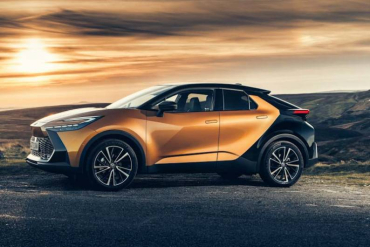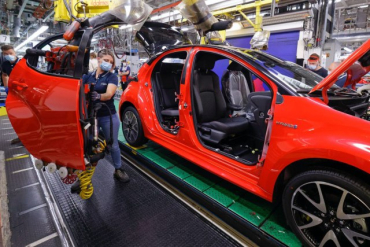Displaying items by tag: Toyota
Toyota C-HR PHEV review
Is it really necessary to have PHEV power in a Toyota C-HR? Jonathan Crouch decides.
Ten Second Review
Top versions of the second generation C-HR gain the PHEV powertrain Toyota thought unnecessary in this small coupe-crossover model's original predecessor. You could almost treat the resulting confection like a full-EV for commuting duties, but inevitably, there's a price to pay for the extra sophistication.
Background
Toyota's always seemed very undecided about PHEV technology. Having virtually invented it back in 2012 for a top version of the Prius, it took nearly another decade for the brand to offer it again on another model (the RAV4). Questions to the company as to why smaller Toyotas couldn't be had with Plug-in Hybrid tech were met with the response that the benefits of PHEV were "largely illusory" and that a better solution was to concentrate on conventional Hybrids.
But everyone's allowed to change their mind and Toyota clearly has in developing the second generation C-HR crossover we're looking at here, which now has a headlining PHEV model at the top of its line-up. Most sales will continue to be of the self-charging conventional Hybrid versions of this model, but let's take a closer look at whether plugging your C-HR in might be a credible option if you're planning to spend big on this model line.
Driving Experience
Most PHEVs actually aren't very efficient at all, once their EV range is used up. When that happens, they usually revert to a conventional petrol engine made even less efficient by the fact that it has to lug along the extra weight of a Plug-in Hybrid battery pack. The C-HR PHEV has that too, but at least its core petrol engine is a self-charging full-Hybrid, which makes it rather unique amongst models of this genre.
The 2.0-litre engine in question (borrowed from the faster of the two standard Hybrid models) is mated to a 161bhp electric motor powered by a 13.8kWh battery that, when fully charged, can offer an EV range of up to 41 miles. Only the front wheels are driven - with up to 220bhp, which allows 62mph to be dispatched in 7.3s en route to 112mph. To cope with the extra power (and weight), Toyota has added new twin-piston brakes and new ZF frequency-sensitive shock absorbers supposed to improve the ride over high-frequency bumps. There are three driving modes and you can alter the strength of regenerative braking right up to a 'B' setting that offers so much retardation off-throttle that you hardly ever need to use the brake pedal.
As with the ordinary Hybrid versions of this second generation C-HR, Toyota says it's worked on the handling, introducing a wider track and tweaking multi-link rear suspension elements from the larger RAV4. It all sits on the company's usual TNGA-C platform, borrowed from the Corolla. And Toyota says that it's improved auto gearbox response too, though you shouldn't expect too much there.
Design and Build
Apart from different badgework and an extra charging flap, there are no visual differences to set this PHEV model apart from more ordinary C-HR Hybrids. If you liked the edgily-styled first generation C-HR, it's likely that you'll also appreciate the visual efforts Toyota's made with its replacement. As before, dramatic lines, sharp bodywork creases and sculpted headlights catch the eye. Plus the nose gets Toyota's latest 'hammerhead face', there are flush-fitting pop-out door handles and pricier trim levels get two-tone paintwork. A new pre-coloured resin finish for the bumpers also gains gives a two-tone vibe. Contrary to expectations, this MK2 model is a little smaller than its predecessor, 35mm shorter and sitting 15mm lower. It's 45mm wider though and has bigger wheels - up to 20-inches in size.
The cabin features various recycled plastic fabrics, contrasting soft-touch surfaces and a pair of so-called 'sail panels' that stretch from the fascia top into the doors. A 12.3-inch digital dial display features for the instruments and the centre screen is also 12.3 inches in size. You sit quite high, but it's not enough to alleviate the rather compromised rearward visibility.
You access the rear through conventionally-sited door handles. And once inside, you'll be tight on legroom, though Toyota claims that extra space for heads has been freed up by the fact that the optional panoramic glass roof doesn't need a shade. Rear seat visibility is limited and the sloping roof line restricts ceiling space. The boot's restricted too: to extend it, the seat back splits 60:40.
Market and Model
Prices for the second generation C-HR model start from just over £31,000, but you'll be paying in the £42.000-£45,000 bracket for this PHEV version. The 'GR Sport' trim level many will want has 20-inch machined alloy wheels, a head-up display and a JBL premium audio system. Along with bi-tone exterior paintwork, front sports seats with suede-effect upholstery, ambient interior lighting, a panoramic roof and a 360-degree panoramic view monitor.
That's in addition to the usual very complete rosta of C-HR spec. You can tick off a powered tailgate, cloud-based navigation, a wireless smartphone charging mat, 'Apple CarPlay' and 'Android Auto' smartphone-mirroring and an auto-dimming rear view mirror. Plus there's rear privacy glass and a parking sensor system with automatic brake function. There are heated seats and you get a 12.3-inch instrument display, along with a 12.3-inch 'Toyota Smart Connect+' central infotainment screen.
The safety and assistance package includes the latest, third generation Toyota Safety Sense package, with functions including a Pre-Crash System, Adaptive Cruise Control, Lane Trace Assist, Road Sign Assist and Automatic High Beam. In addition, there is a Blind Spot Monitor which links to Safe Exit Assist to help prevent doors being opened into the path of vehicles approaching from the rear.
Cost of Ownership
For this PHEV C-HR variant, you're looking at up to 294mpg on the combined cycle and up to 19g/km, with an EV range of up to 41 miles; in the real world, it'd be more like 35 miles. That claimed range figure puts the car in a very favourable 8% Benefit-in-Kind taxation bracket - which for many customers could be the clincher for purchase. Helping with the range figure is the fact that this second generation design is around 2% more aerodynamically efficient than its predecessor.
On the move, you can select an EV mode or use a Hybrid setting that will work with the sat nav and uses Geofencing technology that will prioritise electric power in low-emission zones. The navigation system can also suggest a route that will take into account your state of charge and identify possible charging spots. In a C-HR PHEV, you can also adjust the strength of the regenerative braking.
The 13.8kWh battery can use a 7kW charger for a home top-up that will take two and a half hours. Whatever C-HR you decide upon, as usual with Toyotas these days, if you keep the car serviced at a franchised dealer, the warranty can be extended up to a maximum of 10 years.
Summary
For a few people, this Plug-in Hybrid C-HR will be the ideal small coupe-crossover confection. Hybrid power when you need an engine. And you can treat the car like a full EV when you don't. What's not to like? Well the added weight for one thing. And the significant price premium for PHEV power for another. So you'll either be a sceptic or a convert when it comes to this model.
But then the C-HR has always garnered that kind of reaction, so why should this second generation model's more sophisticated high-tech flagship variant be any different? In a world undecided about the future of EVs, it might just be an ideal fashionable small runabout for those who don't mind a premium price tag. And then again, it might not. Everyone will have their own opinion, just as they always have with the C-HR.
Source: rac.co.uk
Toyota CEO: There will never be more than 30% electric cars on the road
A billion people around the world live in areas without electricity. Toyota also supplies vehicles to those regions, so electric cars alone cannot provide transportation for everyone.
Toyota will never switch to electric cars only – hybrids and hydrogen will play an important role in the future.
"Regardless of the progress of electric cars, I think they will still have a market share of 30 percent," says Toyota president Akio Toyoda.
After speaking at the Tokyo Motor Show, when asked how he sees Toyota's future plans with electric cars and hydrogen, Toyoda stated that the answer would take four hours, but still decided to answer in four minutes, writes Revijahak.
Many manufacturers and countries are currently working to switch to electric cars only, and the EU will ban the sale of electric cars by 2035. Toyota has completely different ambitions and plans.
"A billion people around the world live in areas without electricity. In the case of Toyota, we also supply vehicles to those regions, so electric cars alone cannot provide transportation for everyone," said Akio Toyoda.
Hybrids have so far been the most successful technology for reducing CO2 emissions. He says that Japan is the only developed country that, thanks to hybrids, managed to reduce CO2 emissions by as much as 23 percent and that the media is to blame for hiding this information.
"Toyota will therefore produce about 30 percent of electric cars out of about 10 million cars produced annually," claims Toyoda. -
"The remaining 70 percent will be hybrids, fuel cell cars and hydrogen," Toyoda concluded.
2024 Toyota bZ3X
At first, Toyota’s bZ4X electric SUV had us scratching our heads. Was this a nameplate left scrambled? An unsolved CAPTCHA? However, after Toyota teased a larger bZ5X SUV, and later this compact bZ3X crossover, the nomenclature makes a little more sense. As another offering in Toyota’s growing bZ (Beyond Zero) model lineup, the bZ3X exists today as a concept, but will eventually fill a C-HR-sized hole in the upcoming bevy of Toyota EVs. Powertrain details including battery size and maximum driving range are still closely guarded, but the bZ3X is an obvious entry into the subcompact crossover segment of the future. This a necessary step in Toyota and Lexus’s plan of 30 new EVs by 2030.
What's New for 2024?
It’s early yet, and Toyota is keeping hush on details about the bZ3X, but we think this almost-production-ready concept could be ready for ordering sometime in 2023.
We’ll have to wait until Toyota spills the beans on powertrain details and equipment offerings before we can suggest a specific bZ3X, but it’s likely Toyota would give its most compact electric SUV the option of single front-motor or fully loaded dual-motor powertrains. That’s something to keep the starting price somewhat admirable as a base model, and likely a higher-horsepower and longer-range top-tier offering.
As more information becomes available, we'll update this story with more details about:
EV Motor, Power, and Performance
Range, Charging, and Battery Life
Fuel Economy and Real-World MPGe
Interior, Comfort, and Cargo
Infotainment and Connectivity
Safety and Driver-Assistance Features
Warranty and Maintenance Coverage
First drive: Toyota Corolla Cross
The best-selling car of all time now has a brother: although younger, the new member of the family is bigger, more powerful, and more advanced.
What did we have? So, in the past couple of years, Toyota has rounded out the cross section of its smaller cars.
In order: the urban Aygo received a version transformed into a new model with the X mark (although it is clearly a cross philosophy), then the (inter)urban Yaris experienced a transformation of character and name, getting a bigger brother also with the cross mark, and this fall the legendary Corolla became a dual personality – the Corolla Cross appeared.
The new issue of Auto magazine is on sale, read the driving impressions of the latest car models.
Although the (relatively speaking) basic models became bigger over time, it was not until the family of cross versions gave them dimensions that practically took them half a class higher in terms of dimensions, as is the case with the newly arrived Corolla Cross, which almost equaled its dimensions with the previous generation of the RAV4 model.
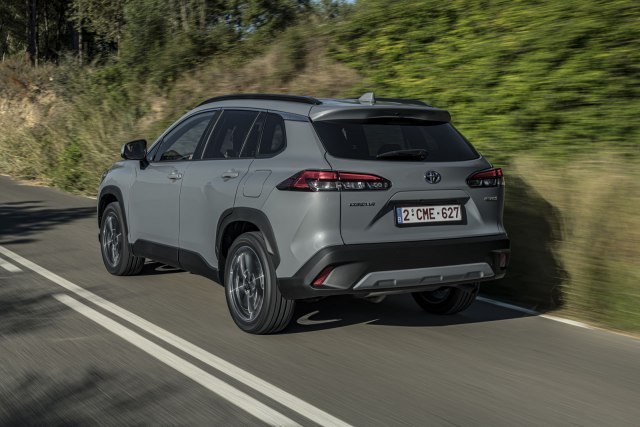
It's hard to precisely categorize the Corolla Cross. Although Toyota classifies it in the SUV category of the C segment, we would rather say that, primarily in terms of its capabilities, this is a "light" SUV car.
Compared to the standard Corolla, the Cross has grown in all three directions, it looks serious, it seems convincing and in its essence it differs from the model from which it is an offshoot.
It was created on the proven GA-C platform, so upgrades and improvements were relatively simple, and the application of new technological solutions was easy.
What explains the breakthrough in a few sentences is the hybrid technology of the fifth generation, the improvement of driving, the application of all advanced multimedia solutions, and, last but not least, the comprehensive systems of active and passive safety.
If we add to that the Japanese commitment to reducing consumption and pollution, then we have before us a technically modern work that rightly bears the family name Corolla, created a little more than 55 years ago.
From the outside, Corolla Cross is unmistakably recognizable as a Toyota - it's trapezoidal forms of headlights, front grills, the lower part of the bumper, along with the same lines of elements on the rear part.
Even the side protective panels follow that design idea. The main lights (in all equipment packages) have bi-led technology. The car is 4.46 m long, and in terms of dimensions it is placed between the C-HR and RAV4 models.
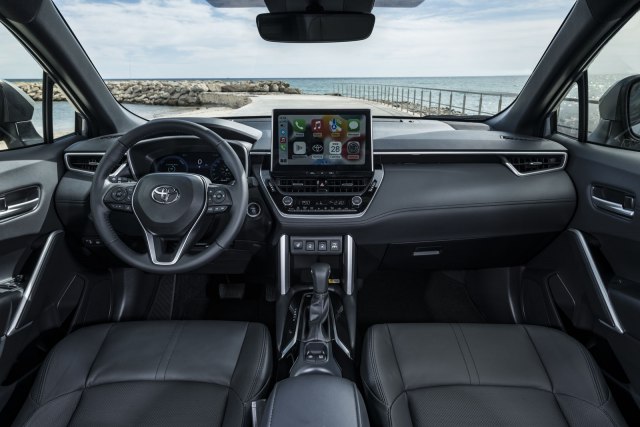
In order for everything to be nicely rounded (not to say bumpy), there are several options of alloy wheels, diameter 17 and 18 inches, in several shades and several combinations of appearance and number of spokes.
The new model is intended for family people, who need comfort, space for children, but also enough space for things in the trunk.
The volume of the luggage compartment is 433 liters, and by folding down the backrests of the rear seats, you get 900 liters of additional space.
The heart of the technology is the latest, fifth generation hybrid system. It is about self-rechargeable battery technology, created 25 years ago.
With each improvement, hybrids become better, bringing more power, with less consumption and gas emissions.
It is a completely new hybrid lithium-ion battery: in addition, it is smaller and lighter, with a capacity that is higher by 14 percent.
As for the gasoline engines themselves, there are two on offer - 1.8 and 2.0 liters, which are installed in front-wheel drive versions, and the possibility of intelligent all-wheel drive (AWD) is provided only with a stronger unit.
However, for now, only the version with a two-liter engine is ready for delivery, while cars with a smaller capacity engine are expected soon, probably in the spring.
Until it hits the roads, just a few basic data about the performance of the stronger engine: its exact displacement is 1987 cc, and the maximum power (combined with the electric motor) is 197 hp, and a maximum acceleration of about 7.5 seconds to 100 km/h .
An important item of this car is the planned smart all-wheel drive option.
Although the Corolla Cross is not an example of a classic all-terrain car, the ability to distribute transmission to the front and rear wheels will come in handy in situations where you lose good contact with the ground, when turning or accelerating.
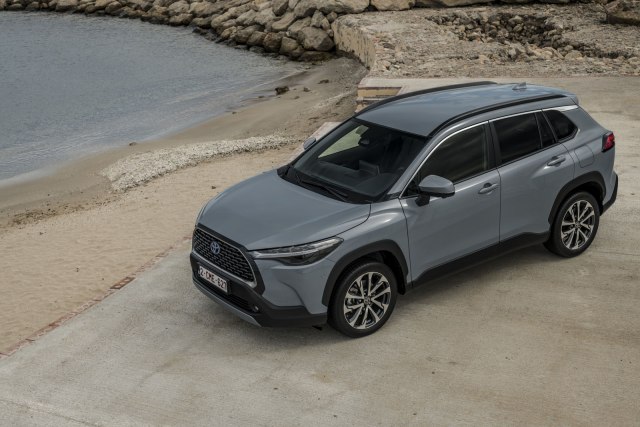
In normal driving modes, power is transmitted only to the front axle, thus reducing consumption.
And, if there is a protective sign Toyota, then it's safety and an almost endless list of systems that protect the driver and passengers.
The starting point is Toyota's technology called T-Mate, which includes protection against almost all risks, from warning of the possibility of a collision, driving assistance, detecting pedestrians or cyclists, obstacles on the road, all the way to assistance when parking or unparking, or navigation in real time.
Meeting the Corolla Cross in person is a surprise, not just because of the car's size, but the character it displays. The car looks strong, but also elegant, large as well as harmonious.
Its height facilitates access from all sides, entry into the cabin is easy and practical, Inside, comfortable seats, steering wheel with optimal dimensions in diameter and circumference.
The digital instrument panel (12.3 inches) dominates in front of the driver, the display of which can be set in countless ways, whether it is the data you want in front of your eyes, or the color.
Even more dominant is the large screen of the multimedia system, with a diagonal of 10.5 inches. Should I say it works faster, better, more…
The Corolla Cross is confident on the road. Quiet, with a quick response on the gas pedal, with smooth acceleration that seamlessly picks up speed, assuring you that the power you need will always be available. And the braking is even, calm, even at higher speeds it won't push you out of the seat.
In a word, comfort is guaranteed, both for the driver and for the passengers, both in the front and in the back. There is more than enough space, and there will be no shortage of entertainment.
Multimedia with connection possibilities via applications, music, wireless mobile phone charger, automatic air conditioning or USB ports...
With the introduction of the Corolla Cross to the range, Toyota has rounded out its range of practical SUVs.
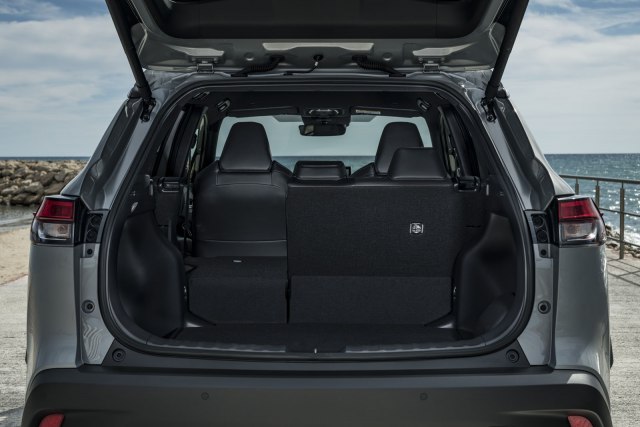
The new model has already arrived in Serbia, we are expecting it soon for a test drive, which will be an opportunity to get to know the model in more detail, which promises good moments behind the wheel, but also the obligation to fulfill the high criteria that buyers of the Japanese brand are used to.
Help
Corolla Cross is equipped with innovative solutions from the T-Mate package for driving and parking assistance: these are advanced parking functions, blind spot control, assistance for safe exit of the vehicle and a reminder of things or people in the back seats.
We list just a few functions that can give confidence to the driver, making driving and parking safer for you, but also for other road users.
Spatial Planning
A convenient load height and boot space mean you'll have room for everything from transporting the kids to enjoying the weekends.
Want more space? No problem! The 60/40 split folding rear seats instantly provide space for suitcases, bikes and anything else you need to take on the road.
Practical space for small items, including a cassette in front of the passenger and a holder for six cups, guarantee that you will have room for everything and everyone.
MyToyota application
When you're busy or driving, the MyT smartphone app provides an intelligent connection between your smartphone and your car, MyT does everything from planning your journey home, to sending you updates and service notifications.
The Hybrid Coaching feature analyzes your driving and tells you how you can improve fuel efficiency on the road.
Toyota Hilux powered by hydrogen
Driven by growing customer demand and Toyota's humane approach to mobility in all sectors, the company recognized a new opportunity in the commercial vehicle market to offer zero-emission products.
Last year, Toyota successfully applied for funding for the activities of the APC (Advance Propulsion Centre), representing a project that contributes to the development of new, cleaner technologies and solutions for mobility. APC plays a fundamental role in the UK automotive segment and offers unique opportunities to bridge the gap between manufacturing and future technology requirements. This funding specifically supports the later stage of research and development that follows the product from proof of concept to prototype vehicle.
A consortium led by Toyota Motor Manufacturing (UK) Ltd. (TMUK) will receive funds to cover the cost of developing fuel cell powertrains for the Hilux model. In collaboration with highly skilled UK-based technical and engineering partners Ricardo, ETL, D2H and Thatcham Research, the project aims to win production of the second generation of Toyota fuel cell components (already used in the latest Toyota Mirai). , to transform the Hilux into a fuel cell electric vehicle.
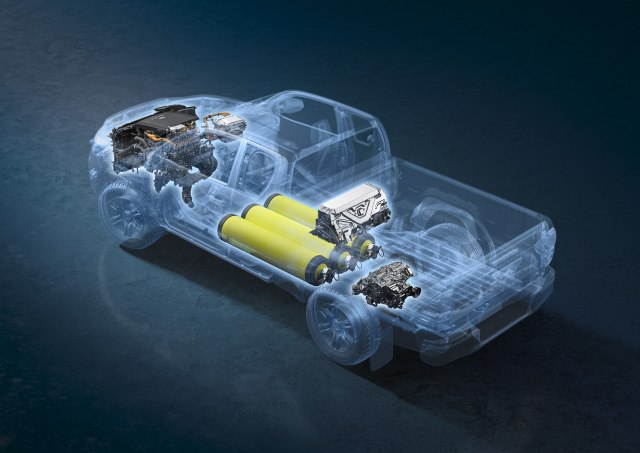
TMUK will lead this project, while a team within Toyota Motor Europe (TME) R&D will provide expertise and technical support, to enable other teams in the UK to build their own technology and become ready to develop the next generation of hydrogen propulsion.
For more than 20 years, Toyota has promoted a comprehensive approach to carbon neutrality by offering a diverse range of vehicles, including all electrified technologies, hybrid-electric, plug-in hybrid-electric, as well as battery electric and fuel cell electric cars.
The successful development of the hydrogen-powered transport sector is an essential element for reaching this goal. As part of the offer, the first prototype vehicle will be produced at TMUK's facilities in Burnston during 2023. After achieving successful results, the goal is to prepare for small series production. This project represents an exciting opportunity to explore the possibilities of further applications of Toyota's fuel cell technology in the vehicle segment, which is key to a number of industries, and which will help support the sector's move towards decarbonisation.
"Great Britain is one of the key markets for pick-up vehicles, but it is also an important market for Toyota. This investment represents a huge opportunity to develop solutions for zero emission vehicles in a very important segment of the market. We would like to thank the UK Government for the financial investment that will enable the consortium to explore further development of fuel cell powertrains for the Toyota Hilux model, supporting our plans to achieve carbon neutrality”.
You won't believe how much Tesla makes more than Toyota per car sold
The sales margins enjoyed by the American electric car manufacturer Tesla are just a dream for traditional manufacturers. Tesla as a company started slowly, but for years it has been proving that it is possible to profit from electric vehicles.
The best example of Tesla's sales margins is their comparison with one of the world's largest car manufacturers - the Japanese Toyota. According to the latest financial results, Tesla earns as much as eight times more per car sold than the Japanese icon of the automotive industry.
Toyota has been at the top in terms of the number of cars sold for decades, and it can definitely be said that the Japanese company has the knowledge and skill to create successful products that bring profit. What's more, while Toyota hasn't turned to all-electric cars as quickly as many manufacturers, most of their lineup is hybrid-powered, and some of them are available as plug-in hybrids.
On the other hand, Tesla still produces only four electric models (5 if the Semi truck is also counted). That's why it's interesting how Tesla earns eight times more per car sold than Toyota. Although the math is not that precise, the fact that Tesla makes much more per unit cannot be disputed.
During the third quarter of this year, the American company reported $3.29 billion in profit, while Toyota's profit for the same period was $3.15 billion. During those three months, Toyota delivered eight times more vehicles to customers than Tesla globally.
Toyota confirmed: The new Prius will arrive on November 16!
The fifth generation of Toyota's pioneer of hybrid technology.
Toyota has finally confirmed that the mysterious hybrid model, which was recently announced by the company, is indeed the new generation Prius, whose online premiere will be held on November 16.
The new teaser reveals some design details of the model, including aggressive headlights that are somewhat similar to the recently revealed Toyota Crown.
The sharp lines of the LED headlights and the dynamic lines on the hood emphasize the Toyota emblem on the front fascia.
The profile is sleeker than previous generations of Prius, while maintaining a focus on aerodynamics and 5-door body style.
Another detail that we see in the teaser more clearly than before is the emphasis on the rear sides of the "tail" of the vehicle.
Toyota describes the new Prius as "Hybrid Reborn". This model has always been a pioneer in terms of hybrid technology, so we expect Toyota engineers to further improve the efficiency of the powertrain, as well as driving dynamics and safety technology.
Reports from Japan reveal that the model will be based on the new E3 mechanical platform, using components from the proven TNGA-C base and architecture used exclusively for the bZ series battery electric vehicles.
In addition to the "classic" gasoline-electric hybrid, which will most likely be offered from the beginning, there have been rumors of a hydrogen-electric hybrid coming in 2025.
The latter could be the first production model to use Toyota's hydrogen SUS engine although nothing has been confirmed by the manufacturer at this time.
More details about the new Prius will be revealed next week, and we wouldn't be surprised if Toyota continues the teaser campaign through its social media channels over the next few days.
Here are the cars for which fake manual transmissions are being prepared
Electric cars have motors mounted directly on the axle, or axles in some cases. This means that the power is transmitted directly to the wheels, so there is no need for a gearbox of any kind. However, some manufacturers are considering using fake manual transmissions for electric vehicles.
With the advent of electric cars, the need for any kind of gearbox has disappeared, which also means that many enthusiasts will be disappointed by the inability to change gears.
Toyota recently filed for patent protection for a clutch pedal transmission for electric cars. On the other hand, Honda recently announced that it is not considering the introduction of fake manual transmissions for electric vehicles.
CEO Toshihiro Mibe and head of electrification Shinji Aoyama confirmed that fake manual transmissions will most likely not be available in future Honda electric vehicles. This includes two sports cars announced in the Japanese manufacturer's electrification plans.
Manual transmissions, primarily in the form of control, interaction and precise timing between the three pedals and the gear lever, make driving fun. Honda says it will find other ways to make electric cars fun to drive, but fake manual transmissions aren't an option.
Speaking of which, it looks like there won't be any Hondas with a manual transmission anytime soon, or even conventionally powered ones. For example, no Honda available on the Serbian market has a manual transmission option, while on the global market it is still possible to get Civic and Integra models with manual transmission.
As for the upcoming electric electric cars, Honda claims they won't have three pedals, and won't make fake noise in line with fake revs. Toyota is certainly planning such a system for its electric cars, and we will see who is right in a few years.
2023 Toyota Crown Courts Controversy
Toyota embraces polemical design with the Avalon's tall four-door successor, the 2023 Crown.
Nobody ever argued about the Toyota Avalon, which was universally described as "perfectly nice." But Toyota, in case you haven't noticed, is no longer content with inoffensive competence. So it replaced the Avalon with the 2023 Crown, a jacked-up four-door coupe-roof sedan that looks like a 1999 Subaru Legacy SUS and a Local Motors Rally Fighter had a baby. The fact that this thing succeeds the Avalon reveals a lot about Toyota corporate culture right now, which we imagine as Rumspringa in Toyota City. What will it build next, and will it be the result of a dare?
The Crown—a nameplate that dates to 1955 in Japan—is 3.7 inches taller than a Camry and twice as extroverted. The high-riding stance is mostly posturing, given that the Crown's ground clearance is only 5.8 inches, just a tenth of an inch higher than the Camry's. But its optional 21-inch wheels look concept-car enormous on a vehicle this size, and the Platinum model's available two-tone paint brings some Maybach attitude to the near-luxury-sedan segment.
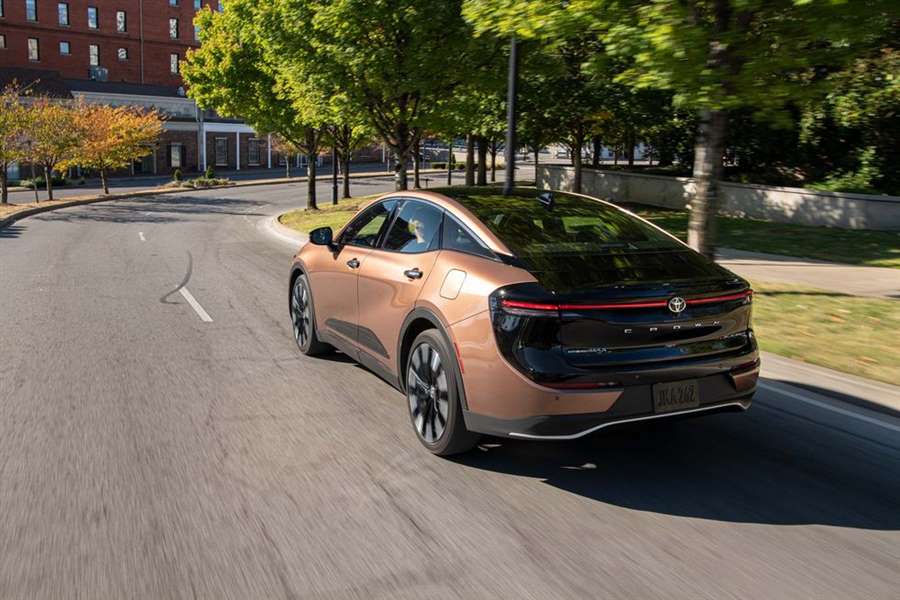
The Crown's two available hybrid powertrains differ in more than just power output. It's really like there are two Crowns—the base XLE and Limited for people who might actually be replacing an Avalon, as well as the Platinum Hybrid Max models that step brazenly into Lexus territory in terms of pricing and performance. All-wheel drive is standard either way, with the XLE and Limited using a naturally aspirated 2.5-liter four-cylinder paired with three electric motors to deliver a total of 236 horsepower through a continuously variable transmission. The rear axle is electric-only—there's no driveshaft—and its motor makes 54 horsepower and 89 pound-feet of torque. That's enough, Toyota tells us, to ensure that all-wheel drive remains available at all speeds, although we can't imagine the rear end is doing much if you boot it at 80 mph. This powertrain isn't the enthusiast choice, with Toyota claiming a safe and sane 7.6-second 60-mph time, but it does have an impressive EPA combined fuel-economy rating of 41 mpg. Curiously, while the revised 2023 Corolla Hybrid gets a lithium-ion high-voltage battery, the upmarket Crown sticks with nickel-metal hydride.
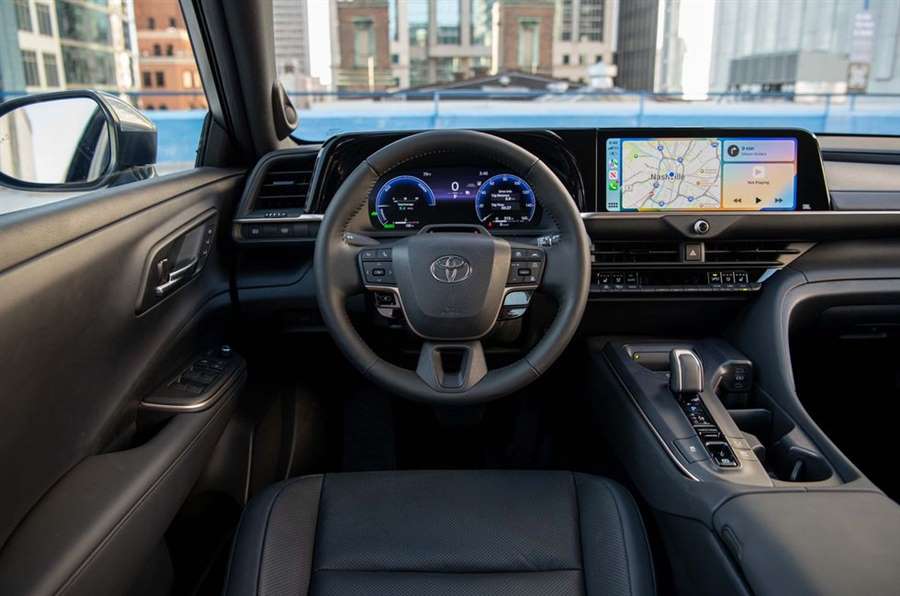
The optional Hybrid Max powertrain, available only in the Platinum, more closely aligns the Crown's performance with its bold sheetmetal. A turbocharged 2.4-liter four teams up with two electric motors to deliver 340 horsepower and 400 pound-feet of torque, while EPA combined fuel economy drops to 30 mpg. In the Max, the water-cooled rear motor makes 79 horsepower and 124 pound-feet and is always engaged (the base powertrain goes front-drive until the rear wheels need traction). Stacking the gains, Toyota bolts the turbo four to a six-speed automatic that uses a wet clutch instead of a torque converter. Hello, silky rev-matched downshifts. Intriguingly, the clutch will allow a high-rpm launch-control mode, which Toyota says is in the works and would likely drop the claimed 5.7-second 60-mph sprint even lower. The Platinum trim also gets adaptive dampers that make the Crown a surprisingly willing partner when the road gets twisty.
Inside, the Crown's cabin is reminiscent of the dearly departed Land Cruiser—not flashy but impeccably assembled with quality materials. It looks as if a scuffed driver's seat bolster might be the only tell when the odometer hits 200,000 miles. The Platinum's leather front seats are heated and ventilated, and the rear seats are also heated. The sleek climate control panel, immediately below the 12.3-inch touchscreen, would look perfectly at home in a $100,000 Lexus. The only letdown is the 11-speaker JBL audio system in the Limited and Premium (XLEs get a basic six-speaker system). The JBL sounds as if 10 of its 11 speakers might be tweeters, and yes, we checked the settings and tried different cars. Toyota says the system was "acoustically tuned for Toyota Crown to match unique vehicle characteristics," so maybe that means it expects the Crown demographic to listen to crime podcasts and NPR.
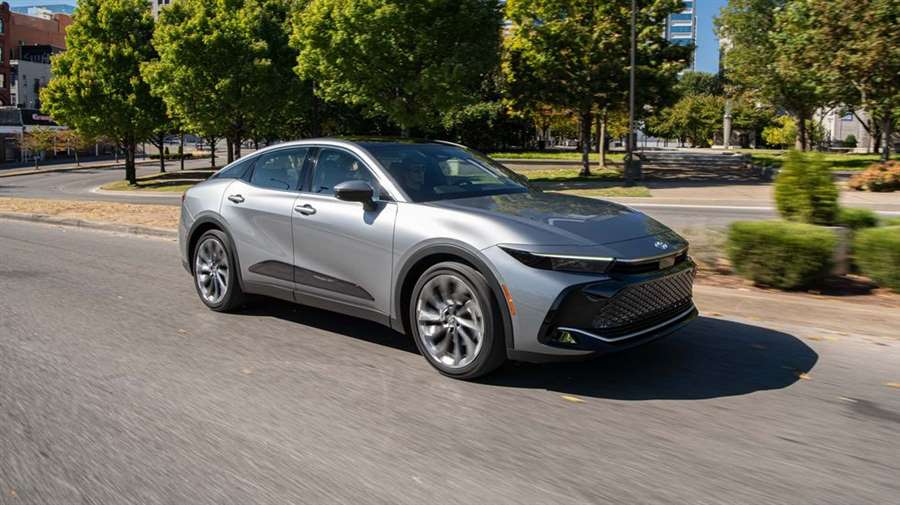
Like the old U.S.-market Land Cruiser, the Crown is built solely in Japan, at the Tsutsumi plant. And perhaps Toyota hopes that the Crown might capture a few orphan Land Cruiser owners in search of that signature anti-brand-snob Toyota luxury experience. Crown pricing starts at $41,045 for an XLE and ranges up to $53,445 for a Platinum. Is that too expensive for a Toyota sedan?
We'd say not, but the Crown's value proposition is up for debate as much as its style. Toyota hopes to sell about 20,000 Crowns a year in the U.S., which is a healthy goal but not one that demands mainstream conformity. Maybe you hate the way the Crown looks—that's fine. Toyota is fully aware haters gonna hate, and it truly doesn't care. If we're bickering over the Crown, we're talking about the Crown.
To that point, you don't offer two-tone paint if you're looking for unanimous consensus. That option, only available on the Platinum, brings a gloss black hood, roof, and rear decklid, set against extroverted lower-body colors like "Bronze Age." The two-tone paint costs $550 extra, and we'd say it's mandatory. But we'd be happy to argue about it.
Source: caranddriver.com
New car buyers trust Toyota
J.D. Power's 2022 Car Brand Loyalty Study has just been released, and among new car buyers, one brand stands out as a favorite.
Actually, there are four of them, but only one dominates the two categories of this established research. That brand is Toyota, although Ford recorded the highest percentage of loyal customers by a slight margin compared to the Japanese brand.
This study is now in its fourth year, and involves exclusively surveying new car buyers. In addition, it is focused on those people who practice shopping "old for new", staying true to the brand. Therefore, the survey includes only authorized sellers, using data from J.D. Power's news networks. There is good demand for used cars at the moment, but this study provides an interesting insight into the loyalty of customers who are patient enough to wait for the delivery of their new tin pet, given that stocks are reduced.
Toyota has quite a loyal following. The Japanese manufacturer is ranked in the leading position in the category of mass-produced cars and SUVs/crossovers, achieving a loyalty rate of 62.2 percent for passenger vehicles and 63.6 percent when it comes to SUVs/crossovers.
Of course, premium brands are also ranked, and among them are the leading Porsche with 57.4 percent, i.e. BMW, which reigns in the SUV/crossover class with 58.6 percent. Pickup trucks are the final category in the survey and it is naturally dominated by Ford, whose loyalty rate is 63.8 percent, which is slightly better than Toyota in terms of the best result.
"There are many ways to cultivate customer loyalty, but each winning brand demonstrated a commitment to fresh product launches, great processes focused on vehicle owners, great residual value and an attractive offering," said VP J.D. Data and Analytics Power, Tyson Jomini. "And they're the ones who are winning the most in terms of market share."
In the premium segment, Genesis in the car category (54.6 percent) and Lexus in the SUV/crossover class (56.4 percent) also rank well. Second place among mass-produced manufacturers went to Kia (54.1 percent) and Subaru for SUVs/crossovers (62.6 percent). Toyota almost didn't get the third title, finishing behind Ford in the pick-up truck category with 58.7 percent.

